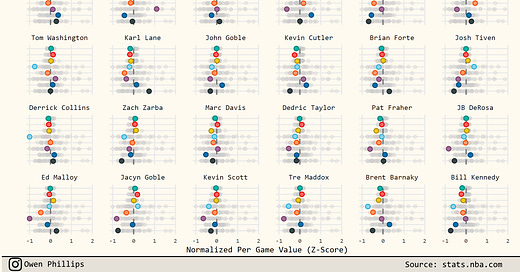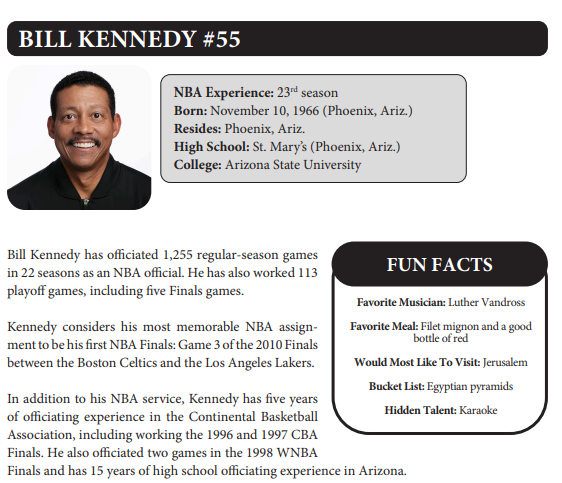Editor’s Note: This post has been updated after a reader (h/t Ivan) found a mistake in the code used in the referee analysis. The intern (me) that made the mistake has been executed by guillotine.
The NBA is the only professional sports league I can think of where some of the referees have reputations as outsized as some of the players. Finding out that Scott Foster is officiating a game involving your favorite team is as demoralizing as finding out your star player is going to try and play through an injury. Your mind immediately goes to dark places.
And yet, we don’t have great data on the individual actions of referees. Most of the referee data I’ve looked at is aggregated at the crew level, meaning it’s impossible to distinguish between the actions of the three referees that are officiating the same game.
So for the last couple of years I’ve sifted through the NBA’s play-by-play data to track whenever a referee calls a foul or violation. Every time Scott Foster calls an offensive charge or Josh Tiven blows his whistle for a personal foul, it goes into the NBA’s play-by-play feed and into my searchable database.
Recently, I finished collecting all the foul data from this year’s regular season. Since the 36 referees that are officiating this year’s playoff are selected based on some formula that takes into account their regular season performance, I thought now would be a good opportunity to take a look at different referees’ tendencies.
The chart below shows how often each referee called common fouls and violations on a per game basis during the regular season1. In order to allow for easy comparisons across the different foul types, I’ve normalized the per game values and converted them to z-scores. The further a dot is to the right on the chart, the more often that type of foul is called by that referee.
In this chart I’ve sorted referees by their average z-score. That means Kane Fitzgerald has a good case for being this year’s most aggressive whistle blower. In particular, Fitzgerald tends to call more loose ball fouls, offensive charges, and offensive fouls than other referees. To be fair, those three foul types aren’t the most frequently occurring ones so the variance with those are going to be higher than with personal and shooting fouls. But an ill-timed offensive foul can swing the balance of game so calling more of those than most of your peers is likely going to earn you a bad reputation among players and fans.
That said, I’m generally skeptical of the idea that any referee is significantly fairer or more biased than any other referee. Most officials blow their whistle only around a dozen times a game so I think fans are usually just overreacting to small sample sizes when they feel like their team has been wronged by a particular referee. Still, I find it amusing to see Fitzgerald, Tony Brothers, and Scott Foster all in the top row on this chart. I think all three of those officials have a reputation for inserting themselves into games and the data suggests that all three of those referees were among the most aggressive with their whistles this season.
Foster in particular is interesting for the fact that he calls every foul and violation more often than most of his peers, with the exception for Defensive Three Seconds. As I’ve written about in the past, some refs give a shit about Defensive Three Second and some don’t. The NBA introduced the Defensive Three Seconds rule in the 2000-01 season and Foster has been around for 27 seasons so maybe enforcing that rule doesn’t come natural to him. Then again, Ken Mauer has been around even longer and he’s among the most vigilant referees when it comes to Defensive Three Seconds. Like I said, some give a shit. Some don’t.
Meanwhile, Bill Kennedy ranks among the least aggressive referees. He calls a less than average amount of fouls and violations across all the different categories. That’s not to say that’s a good thing. While no calls can be great from a neutral fan’s perspective since there are fewer interruptions to the game it can also be frustrating if your team is regularly on the wrong end of them. Just ask Nikola Jokic.
Side bar: I don’t find it surprising in the least that Kennedy’s hidden talent is karaoke and that his favorite musician is Luther Vandross. The man has a wonderful voice.
Whether this data has any predictive value remains to be seen2. But last Saturday I texted a friend before game one between Brooklyn and Milwaukee saying that I thought David Guthrie, the league leader in technical fouls called per game, would call a technical foul that night. Sure enough, with less than two minutes remaining in the game, Guthrie T’d up Blake Griffin after calling him for his sixth foul.
Luka Lacks A Finishing Kick
Luka Doncic carried the Dallas Mavericks as far as he could in the first round against the Los Angeles Clippers, but ultimately came up short. It’s hard to find any real blame to assign to Doncic, but I do want to point out that in the 12 minutes of high or very high leverage situations against the Clippers, Doncic scored zero points and went 0-6 on field goal attempts, according to pbpstats.com.
Obviously, those are small sample sizes, but the result is not unusual for Doncic. Since entering the league, Doncic is one of the few star players that has shown a lack of a finishing kick at the end of games. The chart below shows a player’s points per 75 possessions in medium leverage situations versus their points per 75 possessions in high and very high leverage situations over the last five regular seasons.
Notice the s-shaped curve here. In high pressure situations, role players tend to fade below the diagonal line while star players rise above the same line. In other words, high volume scorers usually level up in the most critical moments. Even if their efficiency takes a hit in the clutch — which is true for almost all players — star players still end up increasing their scoring output because they can dial up their usage. But Doncic’s scoring output actually decreases in high and very high leverage situations, in part because he doesn’t have another level to go to. As you can see in the chart below, Doncic is one of the few stars whose usage rate remains essentially the same in medium leverage situations and high/very high leverages situations.
This gives some support to the idea that Doncic wears down as the game goes on and that there are limits to running your whole offense through a single player unless they’re in other worldly physical shape like James Harden or Russell Westbrook. Asking Doncic to kick it into higher gear after carrying an oversized burden earlier in the game is probably unreasonable to ask for at this point in his career.
Memory Lane
Now that Nikola Jokic has officially been announced as the MVP, do yourself a favor and revisit this unforgettable NBA Reddit thread from 2016.
“Jokic or Okafor. Who would you rather have for the next 8 years?”
It’s tempting to say that this data is useless since the position of the referee will dictate what types of fouls and/or violations they call (i.e., the referee on the baseline will call more Defensive Goaltending violations than the referee at the timeline). However, to the best of my knowledge, referees rotate positions throughout the game and over the course of the season time spent at each position should roughly level out.













